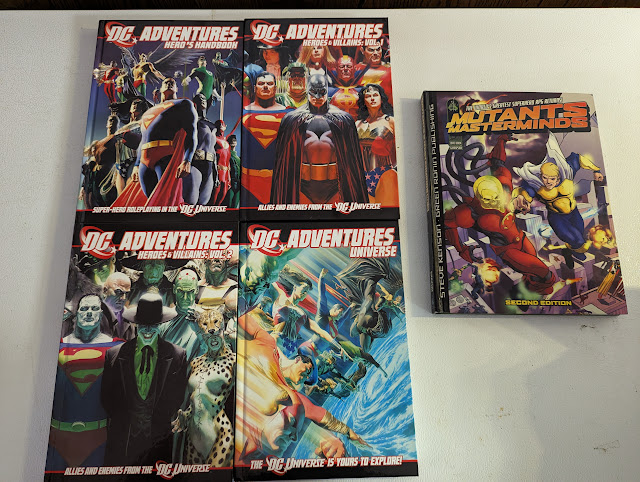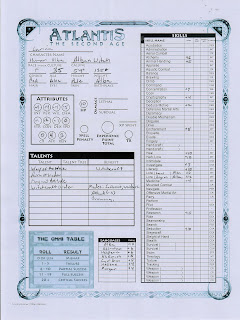I am continuing on my journey through the titles of Appendix N, looking for the Witches that haunted those pages. This week, I have Part 2 of my overview of the Witches of Robert E. Howard, this time focusing on his horror tales. As I covered in
Part 1 of Howard, his DNA is deeply woven into the core of D&D. This is easy to see in Conan, the wandering mercenary (in many tales) having adventure after adventure. what I didn't expect was see so much, maybe even more, from his tales of horror.
Howard's horror runs all over the place. He was obviously significantly influenced by Celtic history, especially with his Bran Mak Morn character, and a lot of these feed into his horror tales. There is a Conan-like character in his "The House of Arabu" doing battle with none other than Lilith herself and other demons. He even dips into Lovecraftian tales. Now, some people have called these "pastiches," but to me, they are nothing of the sort; they are original contributions to the mythos that are every bit as valid as Lovecraft's own and on par with Clark Ashton Smith. Where Howard shined, though, was "Southern Gothic"; he was to the south and south-west (esp. Texas) what Lovecraft was to New England. Many of tales are interlinked and there is some good opportunities for deep scholarship on how his tales link to each other and to his contemporaries (like Lovecraft) and even how his stories influenced others. I can't say for certainty, but his tale "The Haunter of the Ring" (already steeped in his own mythos connected to Conan) feels like it could have influenced Fritz Leiber's "Conjure Wife."
What really surprised me was not that Howard was a good writer; he is full stop. But how great his horror stories are. Lovecraft himself sang Howard's praises, and he was worthy of them.
So who are the witches of Howard's Horror tales? Let's take a look. Instead of going by witch, I am going to go by tale. Each witch is very much situated in each tale.
"Sea Curse" (1928)
Moll Farrell is an archetypical "Sea Witch." She lives in an old hut near the sea, where the tide almost comes to her doorstep, with her daughter. She collects shells and mussels and everyone thinks she is a witch. She proves it by laying a deadly curse on the two men who raped and killed her daughter. The men die, more or less, at each other's hands.
The tale drips with old-world superstition, the inevitability of doom, and the slow, creeping vengeance of the sea. Moll is an agent of vengeance and could have been found on a different coast on the Atlantic in some Celtic dream-hidden past.
The best part of the tale is the Ghost Ship filled with sailors who have committed foul crimes coming up from Hell to take the souls of the men. The image is fantastic.
"Rattle of Bones" (1929)
A short Solomon Kane tale involving a haunted inn, a skeleton that rises from its resting place, and hints of ancient sorcery. Our "witch" here is an ancient necromancer from Russia who comes back from the dead for his vengeance. Not explicitly a witch, but the tale feels like it was ripped right out of a D&D adventure.
"The Hills of the Dead" (1930)
Another pivotal Solomon Kane story where Kane teams up with N’Longa, a powerful African shaman and necromancer. N’Longa gifts Kane the magical Staff of Solomon, a potent artifact used to destroy vampires. N’Longa’s magic includes spirit possession and resurrection.
N'Longa's magic is called "voodoo" but that word wasn't used in Kane's time. The religious practices that went into voodoo (Vodún) did exist.
Again, no explicit witch, though N'Longa is a great character, this tale is great for the abandoned city of vampires.
"Dig Me No Grave" (1937)
What would you get if Howard decided to write about the death Aleister Crowley 10 years before he died? You might get something very much like "Dig Me No Grave."
This tale deals with the temptation of forbidden knowledge. A scholar inherits an occult tome linked to a demon-worshipping cult. The story is Lovecraftian in tone, but the ritual magic and descent into damnation echo the witch-pact trope.
"The Children of the Night" (1931)
This tale is filled with ideas that Howard would come back to many times.
First, there is the dream/reincarnation story that ties modern characters to ancient, savage rites. In later tales he even he explicitly links Conan and Bran Mak Morn to modern day people.
Secondly, it features the Serpent People and hints at sorcerous cults and blood sacrifice. The Serpent People are the literary creature from whence a lot of D&D monsters spring. The Yuan-ti and Ophidians are the obvious ones, but in truth, these creatures bear more than a little resemblance to the class D&D Troglodytes. It might be that these were the root of those creatures.
Third, and this one is big, it contributes to the Lovecraftian mythos by introducing the "Unaussprechlichen Kulten" of von Junzt. This is it's first appearance in print. This is one of the reasons why I say that Howard is not an imitator of the Lovecraftian mythos, he is a bona fide contributor.
Lastly, the infamous "Black Stone," which will feature in many of his tales in one form or another.
"The Black Stone" (1931)
Speaking of which. This tale also features the Black Stone and "Unaussprechlichen Kulten."
Arguably Howard’s most Lovecraftian tale. A monolithic stone and the rites performed there by a degenerate cult speak to primal, prehistoric sorcery. There’s an implied witch-queen who led the rites. The monolith is now located in a village in Hungary called "Stregoicavar," meaning something like "Witch Town."
Howard gives us a lot of history with ancient rites and even connects this to Margaret Murray's work on the Witch Cult of Europe. The toad-god the witches are worshiping is likely CAS;s Tsathoggua, a creature who would appear again in "The Thing on the Roof."
The Necronomicon gets name checked here as well.
"The Thing on the Roof" (1932)
This tale features forbidden books (Unaussprechlichen Kulten) , temple ruins, and an occultist who ignores all warnings.
There is even a pre-Aztec Lich worshiping evil gods (likely Tsathoggua, but only described as a toad-like thing), and evil rituals.
I included this tale and the previous two not so much for their witches, but for their cults and their connection to the Mythos.
"People of the Dark" (1932)
A man relives a past life where he was involved in betrayal and murder. This tale our narrator, John O'Brien, is the reincarnated Conan, and he enters Dagon's Cave to kill a rival for the hand of a woman. This one features almost everything. Conan, Lovecraftian connections, and even the Little People/Children of the Night.
"Worms of the Earth" (1932)
Bran Mak Morn allies with a banished witch named Atla to awaken the Worms, ancient subterranean horrors, to take vengeance on the Romans. The story is primal, grim, and unrelenting.
The worms appear to be another name for the quasi-human Children of the Night. The more and more I read about them the more I am convinced this where the D&D interpretation of the Troglodytes came from.
Alta, the witch-woman of Dagon-moor, is one of our very few named witches. She is half-human and "half-worm" or Children of the Night. The implication here is that the Children were human or at least akin to humans. She is human enough that her price to help Bran is that he must spend the night with her. Likely meaning there is some new half-human descendant of Bran out there now.
This also features the Black Stone. Are these pieces all part of the monolith of ancient times? Hard to say. The piece that Bran uses is small enough for him to carry.
Dagon's Moor, Dagon's Meer, and Dagon's Barrow are all mentioned here as further connections to the Mythos.
"The House of Arabu" (1952)
This tale was also published as "Witch From Hell’s Kitchen" though that title doesn't do it any justice.
This tale features Pyrrhas, who is Conan in all but name really. Our main antagonist (well...) is Lilitu (really summoned by one of Conan's, I mean Pyrrhas's enemies), she appears very much as does the Lilitu of ancient myth with her mate Ardat-Lili. Of course Ardat-lilî is also a female demon (like the same sources as Lilitu) so imagine my humor when Howard describes Ardat-Lili as male. I guess somethings were still a bridge to far when he wrote this.
There are spells and the most interesting thing to me is the Lilith - Tiamat connection. Something I have explored more on these pages.
"Black Canaan" (1936)
Southern gothic horror meets voodoo-style witchcraft. The antagonist is Zekura, a beautiful and deadly sorceress who wields spiritual power and commands zombies. She’s both feared and revered.
Normally I don't comment on the racism of some of these tales, but this one seem a bit much even for the time. Or maybe I just know how bad it actually was. Apropos of nothing, Lovecraft thought this was one of Howard's best tales.
"The Haunter of the Ring" (1934)
A ghostly avenger stalks the land after being wronged in life. The haunting is linked to curses and violated oaths. No witches, but damn, this feels like it could have influenced "Conjure Wife."
It does feature the Ring of Thoth-Amon, a magical artifact possessed by a spirit that can possess its wearer. A form of sympathetic magic, where the curse leaps through the ages. This ring has appeared in Conan tales before.
"Pigeons from Hell" (1938)
Howard’s most famous horror story. Southern gothic with heavy voodoo and ghost-witch elements. A woman in the Blassenville family turned to witchcraft and exacts revenge from beyond the grave as a zuvembie. Features zombified servants and spectral appearances.
Stephen King called this Howard's finest tale.
--
So there is a lot to dig into here. Howard obviously had heard of or read Murray's Witch Cult Hypothesis, since so many of tales embrace the central themes. Where Murray saw a continuous line of ancient fertility cults in a positive light, Howard saw an ancient pre-Christian and degenerate religion honoring dark, forgotten gods. In reality both points of view are as real as the other, and both suit my purposes well.
Moll Farrell and Atla are his main "named" witches, and each serves her role well. Moll feels like a solid Sea Witch, whereas Atla is something else. I have been exploring the concept of "Dragon Witches" within a tradition I've coined the Scaled Sisterhood. I could include ideas from ancient serpent cults too.
Again, no "Conclusion." I want to venture deeper into the tales of Kull, Solomon Kane, and Bran Mak Morn for Part 3.






.jpg)
.jpg)












.jpg)


